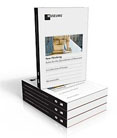
Despite being classified as a 'creative person' because of my background in visual arts, I actually think of myself as a logical person. I like facts: information needs to be concise, clear and preferably interesting. The first thing I noticed from Rules for the (R)evolution of Museums is the absence of any editorial introduction setting out major themes and organising principles. How am I supposed to know what the book of essays is about? I noticed too, from the table of contents, that the essays are not grouped into sub-themes. I managed to put these discouraging first impressions aside and dived into the unknown.
The collection of 20 essays turned out to be well-written, concise, clear, informative and engaging. The authors of each essay focus on experiences and programs from their own internationally renowned institution and relate the issues and solutions back to a wider context. The main themes addressed in New Thinking: Rules for the (R)evolution of Museums include communication, inclusion and social change. The essays are wide-ranging in subject matter: from how the museum shop plays into the visitor experience, to children and adult learning, science centres, how objects speak and on what levels and how stories or objects can be misinterpreted depending on curatorial focus.
The essay for which the collection is named, 'Rules for the (r)evolution of museums', by Elizabeth Wood from the Indiana University – Purdue University, presents seven rules that can be applied to the everyday business of a museum. These rules don't seem profound, radical or even to present a new way of thinking but are, rather, simple, direct statements that resonate with logic. These rules provide the themes that run throughout the book. Rule 2, 'Don't be a know it all', and Rule 6, 'Keep it local', build the mission and values of community inclusion. Rule 7, 'Objects are given meaning by everyone who encounters them', provides an introduction to the importance of objects and their stories, while Rule 5, 'Look for the possibilities, invite change', addresses social inclusion. These rules provide a refreshing operational practicality to help museums face the challenges of dealing with the effects of social change and new forms of communication and technology.
A theme that reappears throughout the book is social inclusion. While many museums claim to be inclusive, Stephanie Wintzerith's essay, 'Inclusive without knowing it', provides insight into the development processes used by internationally renowned institutions attempting to achieve this utopian ideal.
Rules for the (R)evolution of Museums is at its strongest in exploring the themes of collective memory and community inclusion. The essays, 'Old forms, new purposes' by Victoria Dickenson, 'Collective conversations' by Malcolm Chapman and 'Engaging the public' by Wayne Labor, all focus on these themes. The authors use examples from programs and research from their respective museums, to demonstrate the importance of community and highlight new ways of how the community can interact with and enrich the stories of objects and exhibitions. The significance of objects and their crucial role in the museum is a building block which underlies all the essays.
As a student of museums and collections, this book appeals to me as a window into the real problems and issues that cultural institutions are facing. Although a collection of essays is bound to be 'uneven', the lack of cohesion and an apparent organisational schema diminishes its reference value. The structure makes it difficult to navigate; an engaging introduction and splitting the essays by themes would improve the book's utility and meaning. Overall, I found Rules for the (R)evolution of Museums a bit like a not-quite there MasterChef dish: good quality ingredients, but the assembly and presentation let it down.
